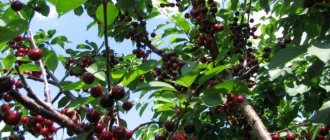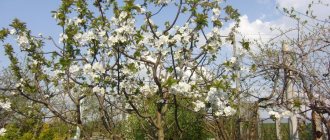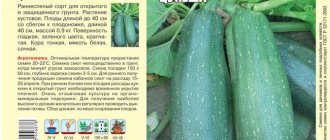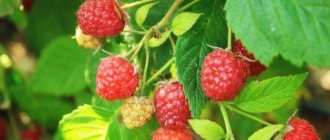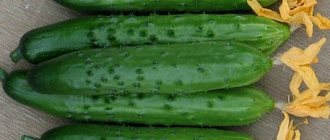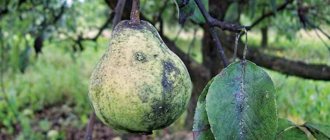Vladimir cherry is a century-old and one of the most popular cherry varieties in Russia with medium-ripe fruits. The Vladimirskaya variety is characterized by frost resistance, productivity, as well as the taste of the berries and their high transportability.
Cherry Vladimirskaya
Vladimir cherries are dense, juicy, and have a pleasant sweet and sour taste.
Vladimir cherry is frost-resistant
Story
The name of the Vladimir cherry is associated with the name of the city of Vladimir. It is believed that the first specimens appeared there from the 7th to the 12th centuries thanks to monks who brought seedlings from Greece. According to another version, the tree was brought from Kyiv by Prince Andrei Bogolyubsky, who founded the Patriarchal Garden. In the 19th century, the city of Vladimir was famous throughout Russia for its cherry orchards, the number of which reached 400.
In the Patriarchal Garden, 5 varieties of Vladimir cherries grew: Roditeleva, Saika, Levinka, Bel and the famous Vasilyevskaya cherries, as well as pears, apple trees and other fruit and berry crops.
Today the Vladimir cherry is one of the symbols of the city. At the entrance to the famous Patriarchal Garden there is a monument to the berry in the form of granite fruits with bronze branches.
A monument to the Vladimir cherry was erected at the entrance to the Patriarchal Garden in Vladimir
The variety was zoned in 1947 and has since been popular among gardeners.
The basis of the garden was made up of cherry trees, mainly Vladimir cherry
How to plant cherry seedlings in open ground
The video demonstrates the technology of planting cherries. How to properly dig a hole, spread the planting mixture, and prepare the seedling. Join the viewing!
Vladimirskaya cherry enjoys constant popularity among gardeners and withstands competition with new varieties. It easily adapts to the climatic conditions of Central Russia and can grow and produce a stable harvest in the northern regions. But do not forget that, despite the unpretentiousness of the cherry, its growth, development and fruiting directly depend on proper and timely care.
Description of the variety
The bushy tree reaches up to 5 m in height. A self-rooted cherry forms a bush. The crown is spherical, poorly leafed, its skeletal branches are drooping, raised at an angle of 60°. The ellipse-shaped leaves have a pointed apex, their edge is doubly serrate (like serrate, but with additional smaller teeth). Leaf length - 8 cm, width - 3 cm, color - dark green.
Mature Vladimir cherry reaches 5 m in height
Flowering begins in May. It takes about 2 months (60 days) before the berries ripen. Medium-sized buds are collected in inflorescences of 5–7 pieces.
Self-rooted Vladimir cherry belongs to the bush varieties
The berries have a black-red hue, the seeds are small. The size of the fruits is average and depends on the conditions (they can be small). The taste of the berries is sweet and sour, harmonious. The variety is valuable in gastronomic terms, dessert, and is one of the most delicious: good both fresh and for all types of processing .
Cherry berries of the Vladimirskaya variety are medium in size
The variety is mid-early. Harvest ripening occurs in mid-to-late July. A peculiarity is uneven ripening, due to which the berries may fall off. The fruits are well transported. Productivity is average, depending on wintering and region (under favorable conditions it can reach 20 kg per tree). Grafted plants begin to bear fruit quickly - in the 2nd–3rd year.
The Vladimirskaya cherry variety is self-sterile, which means that planting only these trees will not bring a harvest; a pollinator variety is needed nearby.
Types of Vladimirskaya cherries
Since cherries have a long history, and many amateur gardeners have been breeding them, they are not a genetically homogeneous variety. Essentially, it is a mixture of closely related cherries that are very similar to each other. You can find the following names:
- Gorbatovskaya;
- Vyaznikovskaya;
- Parenteva;
- Izbylevskaya;
- Dobroselskaya.
Table: pollinators of Vladimir cherry
| Cherry variety | The most important characteristics of the bush | Fruit characteristics | Productivity |
| Lyubskaya | Small trees, up to 2.5 m | Medium and large, sweet and sour taste, universal purpose, suitable for industrial cultivation | Up to 25 kg, bears fruit early, in the 2nd–3rd year, self-fertile |
| Amorelle pink | Trees are medium-sized, up to 3 m | Pink pulp, sweetish-sour taste, suitable only for fresh consumption | Up to 18 kg, bears fruit in the 4th–5th year |
| Fertile Michurina | The trees are low - up to 2.5 m, the crown is very wide, spreading | Good transportability, the variety is zoned in some regions of central Russia | Up to 30–45 kg, self-fertile, bears fruit in the 2nd–3rd year, goes well with Lyubskaya |
Also good pollinators are:
- Turgenevka;
- Griot Moscow;
- Vole;
- The bottle is pink;
- Vasilievskaya;
- Pink fur coat;
- Rastunya;
- Black consumer goods.
Vladimirskaya itself is also a good pollinator and is considered one of the best for Turgenevka and Shokoladnitsa.
The variety has high winter hardiness, but it is not suitable for cultivation in the northern regions of the Russian Federation: low temperatures damage generative buds. This does not lead to the death of the plant, but affects its productivity. In the conditions of the North (Siberia, the Urals), you can get no more than 5–6 kg from one tree. However, in the northern regions, the variety can act as a rootstock (that is, other plants are grafted onto it), and is also the ancestor of some frost-resistant varieties, for example, the Krasa Severa cherry.
Harvesting
Vladimirskaya cherries ripen in early July. The harvest will be spread over two weeks, but ripe cherries need to be harvested as soon as possible, as they can fall off. From one mature tree in a productive year you can collect up to 25 kg of fruit. The berries are dry, so they can be stored in the refrigerator at a temperature of 0–5°C for up to 10 days. A mandatory storage condition is that the berries should not be washed or tightly closed before storing. Vladimir cherry also tolerates transportation well.
The purpose of the fruits of the Vladimirskaya cherry variety is universal. They are consumed fresh, but the famous cherry jam and liqueur are especially tasty. Cherries are frozen, dried, and compotes are prepared.
Selection of planting material
You can buy seedlings in almost any nursery, but among gardeners, material from the city of Vladimir is valued.
How to choose the right seedling:
- It is better to take a grafted annual . It will take root faster than a two- or three-year-old tree and will begin to bear fruit earlier.
- It is worth choosing a well-developed and healthy root system, without traces of insect activity. The best option is a few branches on the tree itself and strong roots.
- You should buy material in the fall.
Best pollinators
We recommend reading our other articles
- How many grams in a teaspoon
- Korean cucumbers for the winter
- Cherry Iput - variety description and care
- Red Scarlet Potatoes
Vladimir cherry produces a good harvest only if there is a pollinator nearby, since in itself it is self-sterile. But not all types of cherries are suitable as a pollinator for Vladimirskaya. The best pollinators in this case are the following varieties: Rastunya, Lyubskaya, Vasilyevskaya, Amorel pink, Turnegevka, Fertile Michurina, Shirpotreb black, Morel black, Zhukovskaya.
These cherries are planted in close proximity to Vladimirovskaya, but so that the trees do not interfere with each other’s growth. If there are one or more pollinators on the site, gardeners can receive an annual and very high-quality harvest of berries.
Determining the landing site
Care should be taken when choosing a location, as the tree will be there for the next 15–20 years. The crown of an adult plant is spreading, round, its approximate diameter is 2–3 m.
An important point is that stone fruits are planted as close to each other as possible. Although this is a controversial issue (some believe that the farther the better), it does not make sense to place Vladimirskaya cherries at a distance of more than 3 m from each other, and for high-quality cross-pollination it is better to keep the distance to a minimum.
When choosing a location, consider:
- the presence of fences and buildings nearby;
- soil properties and groundwater behavior;
- presence of other landings.
Well-cultivated, fertile soils with a suitable mineral composition are preferred. Type - sandy loam with neutral reaction. The place should be bright, preferably south. Fences, enclosures, buildings taking into account the growth of the crown are desirable. Fences will make it easier to organize snow retention in winter, and for Vladimir cherries, a mild wintering is very important .
Before planting, the area is dug up, manure (up to 15 kg per 1 m2), superphosphate or phosphorus flour, and potash fertilizers are added, 100 g of each.
Cherries are sensitive to excess moisture. The proximity of groundwater will inhibit tree growth and affect crop yields. Check the location of the water - it should not be closer than 1.5–2 m from the soil surface.
Before planting, the top part of the tree should be trimmed to 60–80 cm. In the southern regions, the plant is planted in a permanent place in the fall, in cold regions - in the spring. If the seedling was purchased in the fall, for preservation it is buried (Fig. 1 and 2) in furrows 35 cm deep, laid at an angle of 40°, the crown is positioned to the south, the roots are covered, the soil is compacted, and watered. The ground part of the tree is covered with spruce branches - this will protect the branches from freezing and rodents.
For the winter, cherry seedlings must be buried for protection.
In cold regions (Siberia, the Urals), Vladimirskaya is planted only in spring.
Growing rules
Proper planting of Vladimir cherry will also make tree care easier. They will require moderate watering, fertilizing with organic and mineral fertilizers, as well as pruning of shoots. Organic matter is introduced mainly in the autumn. At the time of flowering and fruiting, cherries need phosphorus and potassium.
Vladimir cherry pruning is often done in early spring. In the first 5-6 years after planting, it is of a formative nature, then brightening and sanitary. The variety is not prone to the formation of excessive shoots and thickening of the crown. Damaged branches should be removed regularly.
Preparing for winter
With the onset of cold weather, the remaining mulch and fallen leaves are removed from under the tree. Vladimir cherry is watered abundantly. The trunks are piled high with a mixture of soil and compost. In the middle zone, the trunk is wrapped with a special covering material. Young trees are covered with spruce branches. This will protect the Vladimirovka cherry seedlings not only from frost, but also from rodents, hares, and roe deer.
Planting: step-by-step instructions
The time of spring planting depends on the region. In the Moscow region, it is carried out in the spring, as soon as the snow has melted. To do this, choose a dry, windless and warm day. The holes are prepared in advance - a month before planting, holes measuring 60 cm3 are dug at a distance of 3 m from each other. An interval of 3.5 m is maintained between the rows. A peg is driven into the center of each recess - it will support the young plant. Planting holes are fertilized if this was not done during digging. To do this enter:
- ash - 0.5 kg;
- phosphorus fertilizer - 300 g;
- potassium fertilizer - 80 g;
- manure - 15 kg.
Prepared seedlings (inspected and selected) are planted:
- Earth is poured near the peg, forming a hill of 50 cm.
- The roots of the seedling are spread over the entire surface, sprinkled with earth on top, carefully but firmly compacting it.
- Form a small hole near the tree.
- Water well (for one seedling - 3 buckets of water, which should be at room temperature).
- The watered soil is lightly sprinkled with earth, and the tree is tied to a support.
After planting, the cherry tree must be tied to a peg installed in the planting hole
Video: how to plant cherries
Features of planting Vladimirskaya cherry varieties
The best time to plant cherries in areas with frosty winters is in the spring. To do this, seedlings purchased in the fall are buried or stored in the basement, sprinkling the roots with wet sawdust. Poorly rooted seedlings planted in autumn may freeze in winter. Vladimir cherry must be planted in pairs with a pollinator if there are no already growing cherries of the desired variety nearby.
Choosing a landing site
The planting area should be well ventilated; cherries cannot tolerate stagnant cold air. She does not like swampy, cold and acidic soils, lowlands, and high groundwater levels . Cherries also grow poorly on sandy soils. It suffers from a lack of moisture, but even with watering and the application of mineral fertilizers it grows well, but bears almost no fruit; the wood is poorly prepared for winter and freezes. The distance between trees should be at least 3–4 meters. It is advisable to plant cherries separately from other trees.
Cherry does not tolerate the proximity of black currant, pear, and apple trees. It is better not to plant anything in the circles of cherry trees except peas and garlic. The first enriches the soil with nitrogen, so the roots and stems do not need to be removed, but rather dug up along with the soil in the tree trunk circle. Garlic protects cherries from aphids with its phytoncides.
In a well-lit and ventilated place, Vladimirskaya produces excellent yields
Preparing the site for planting
Before planting cherries, the area must be dug up and cleared of harmful insect larvae and weed roots. When planting in spring, this is done in the fall. Mark and dig holes for seedlings. The distance between trees should be at least 4–5 meters. The size of the hole depends on the soil. The more fertile the soil, the smaller the hole and vice versa. In the middle zone, on heavy loamy soils, holes are made 1 m in diameter and 70–80 cm deep. Fertile soil can be collected in buckets, and the lower layers can simply be scattered around the site; there is no need to add this soil to the planting hole. The pit is filled with fertile soil mixture. It is prepared like this:
- Organic matter is placed at the bottom of the pit. This can be chopped grass, hay, fallen leaves, turf turned upside down, removed when digging a hole, etc.
- Compact.
- Pour out 2-3 buckets of humus or well-rotted compost.
- Add 500–600 g of hardwood ash.
- Fill the buckets with fertile soil from the top layer.
- Pour in 200–300 g of bone meal.
- 200–300 g of dolomite flour to deoxidize the soil.
- Stir lightly without touching the layer of organic matter at the bottom of the pit.
- Water well to allow the soil to settle.
- Mulch with a thick layer of peat, rotted sawdust, pine nut husks, etc.
The more fertile the soil, the smaller the diameter and depth of the planting hole for a cherry seedling.
Selection of seedlings
Seedlings for planting can be purchased at a nursery or garden center. Or you can grow it yourself from a seed or root shoot of an existing tree of this variety. It should only be taken into account that such seedlings begin to bear fruit 2–3 years later than the grafted ones. And plants grown from seed may not reproduce the varietal characteristics of Vladimir cherry. The best results are obtained by propagating cherries using green cuttings. Plants grown this way have an intact root system and take root better. And seedlings obtained from the root offspring of such cherries completely repeat the varietal characteristics of the mother tree.
You need to purchase seedlings from the nearest nurseries, making sure that they are grown here and that the seedlings are guaranteed to correspond to the declared variety. If a tree is dug up before the dormant period, you need to pay attention to its leaves. They should not show signs of disease. The bark is without cracks, stains and signs of gum formation.
If grayish or brown oval or comma-shaped tubercles are present on the branches of a seedling, this plant is infected with scale insects or false scale insects. Such pests can destroy not only individual trees, but also huge gardens. Under no circumstances should you buy such a seedling.
The root system should be branched and fibrous. The roots themselves are no shorter than 30–35 cm, live, and light in color when cut. There should be no swelling or damage on them.
The cherry seedling in the nursery will be dug up immediately during the sale.
Planting seedlings - a step-by-step process
In the spring, as soon as the ground warms up, before the buds open, they begin planting seedlings:
- If they were purchased in the fall and buried, they are taken out of the trench or basement.
- Before planting, the roots of the plants are inspected and damage is cut off.
- Place in water with the addition of Kornevin or other drugs that stimulate root formation for 6–12 hours.
- A stake 1.5 m high is driven into the center of the planting hole.
- Make a hole for the roots so that the root neck of the tree protrudes 5–7 cm above the soil level.
- Place the seedling north of the peg, vertically.
- Straighten the roots so that their ends do not bend upward.
- Sprinkle with the removed soil, shaking the seedling slightly to fill the voids under the roots.
- A hole is formed around the perimeter so that water does not affect the root collar.
- Pour 2-3 buckets of water under the tree in several stages.
- Using soft twine, tie the seedling to the peg with a figure eight knot so that the bark is not injured by the stake, and the plant does not stagger under the pressure of the wind and damage the roots.
- Mulch the tree trunk circle with peat, humus, rotted sawdust, husks, etc., 7–10 cm thick.
Planting cherries - video
Nuances of care
During active growth, the following activities will be required:
- Watering - 3-4 buckets per adult plant. If the summer is rainy, only fertilizing is needed.
- Application of phosphorus-potassium fertilizers based on fruit crops.
- In autumn - moisture-recharging irrigation.
- Soil deoxidation. It is an important point in tree care. Even on slightly acidic soils, cherries will grow poorly, and harvests may not be expected at all. Before planting in acidic soil, it is necessary to add lime. Substances that normalize acidity: potassium and calcium are added in a timely manner.
The variety is characterized by average winter hardiness, so shelter for the winter will not be superfluous. The tree trunk circle is covered with peat, sawdust, and rotted (but not fresh) leaves.
Recent Entries
Lilac perennials that are beautiful, compact and do not crowd out other plants Why when buying seedlings you should not take the sellers’ word for it and how to determine the age of the plant using 3 signs Tomato seedlings have turned purple or whitish: why the color has changed and how to save the plants
To protect against rodents, the lower part of the trunk and branches is wrapped in burlap or any thick paper (newspaper can be used, but packing or wrapping paper is better). Fabric covers are placed on top. This is not very reliable protection against rodents, so you can consider materials such as: plastic bottles, birch bark, roofing felt, iron mesh, nylon tights, spruce branches.
Pruning and shaping the plant
Basic Rules:
- Pruning cherry trees is a controversial issue. If you don’t have confidence in your skills, it’s better not to do it at all.
- In spring, the procedure is not carried out after the buds have swollen, since the risk of fungal infection increases.
- Be sure to remove branches growing inside the crown, dry ones, and damaged by disease.
- Pruning is done in spring and autumn. In the spring - for the purpose of formation, in the fall - as a disease prevention. Summer pruning is carried out only on well-developed trees. In winter, the procedure is unacceptable.
Video: cherry pruning
Caring for Vladimirskaya cherries
The tree requires especially careful care for the first 4–5 years, while the root system grows and the crown reaches the size characteristic of the variety. At this time, you need to especially carefully monitor the condition of the tree trunk circle. It should not be sodded and weeds should not be allowed to grow. Shallow loosening and mulching are required. The root collar should be open.
In an adult cherry tree, the trunk circle can be sown with white clover. It does not grow higher than 15 cm, and the roots enrich the soil with nitrogen.
Trimming
The first pruning of cherries is done after planting, but very carefully. Cherries can only be pruned in early spring, 3-4 weeks before buds open. You cannot shorten the skeletal branches, but only carefully remove the excess ones, cutting them into a ring near the trunk itself. There is no need to leave stumps. The sections are disinfected and covered with garden varnish. It can be treated with regular green paint. The crown should consist of 5–7 branches, evenly distributed along the central conductor. The standard is left 30–40 cm, the branches located below are cut out. The central conductor should be 15–20 cm higher than all other branches.
In the future, make sure that growing branches do not thicken the crown. With good growth of at least 40–50 cm, the branches are shortened, moving to a side branch. Remove crowns growing inward, damaged, drying out, and shading other branches. Weak, poorly growing trees are not pruned . An adult standard tree should form about 10 skeletal branches.
The root shoots are removed, not allowing them to grow much, along with the root from which the shoot originated. Superficial removal of growth will bring the opposite result.
To trim cherries, you should not use pruning shears, which, when cutting, compress and injure the branches. It is best to prune with a sharp garden knife. Immediately clean the cuts, disinfect them and coat them with garden varnish.
Cherry tree pruning scheme by year
Bush cherries only need thinning pruning. Remove branches that grow inside the crown, rub against each other, shade others, dry out and are damaged. of bush cherries are not shortened. Normally, an adult tree of this shape has 15 skeletal branches.
How to trim cherries - video
Watering
Cherries are watered only a few times per season, but abundantly, 10–15 liters of water per tree:
- after flowering;
- during fruit filling 4–5 weeks after the first watering;
- after harvest;
- moisture-recharging irrigation before the onset of cold weather.
Water is poured into furrows 8–10 cm deep, dug around the perimeter of the crown. Do not pour water into a hole that fills the root collar. Water should only fall on the suction roots.
Feeding
The first year after planting, cherries do not need fertilizer. They begin to feed the tree at 2–3 years of age, after it begins to bear fruit. All fertilizing is applied after watering into furrows dug along the perimeter of the crown. You can do without chemical fertilizers, using only organic matter, stove ash and bone meal.
Fertilizing cherry trees - table
| Period | Feeding composition (per 1 tree) |
| After the snow melts | Deciduous tree ash - 200–300 g for digging around the tree trunk |
| Before flowering begins (choose one of those suggested) |
|
| During the period of filling and ripening of berries | |
| After harvest |
|
| Under the autumn digging |
With good care, Vladimirskaya cherries will delight the gardener with a generous harvest
Autumn and spring work on caring for cherries
In the fall, after the leaves have fallen, they carefully dig up the tree trunk circle, incorporating old mulch, ash and bone meal into the soil. Under each tree, apply 2-3 buckets of humus or compost as fresh mulch. In this case, the root collar is not covered. Spray the trees with 3% Bordeaux mixture or a concentrated urea solution (700 g per 10 liters of water).
The trunks and skeletal branches are whitened with lime with the addition of copper sulfate (this whitewash is sold in garden stores). The trunks can be whitened with special paint for trees. Such whitewashing is extremely important for Vladimir cherries, since frost holes and cracks in the bark should not be allowed. It is not recommended to whitewash young trees under 4–5 years old. Their trunks and branches are wrapped with a special bandage. You can use ribbons made from material from bags of sugar. Such a wrap will protect the trunk from frost damage in February - March.
The trunk protected with a bandage is not afraid of the bright March sun and temperature changes
It is imperative to protect trees from rodents. To do this, the trunks are tied from below with spruce branches, a shelter is made from plastic water bottles, and poisoned bait is laid out.
Protecting a young tree from rodents in winter - video
In the spring, fertilizers are applied to the tree trunk circle and dug shallowly to remove the larvae of harmful insects. Trees are sprayed with 3% Bordeaux mixture and pruned.
Fighting major diseases
The most common cherry diseases are moniliosis and coccomycosis. Methods of combating diseases are similar, since they are all bacterial and fungal in nature. It is better to focus on prevention, since it is much more difficult to treat an already infected plant.
Do the following:
- When the buds begin to bloom (green cone phase), treat the tree with Bordeaux mixture 3%.
- As soon as flowering has completed, the plant is again sprayed with Bordeaux mixture (1%) or Skor (1 ampoule per 10 liters of water). Repeat this procedure after 3 weeks.
- In the fall, remove fallen leaves and treat the tree and the ground around it with a 7% urea solution.
- Remove unpicked fruits, avoiding their falling. Infected berries are selected and destroyed.
- Carry out sanitary pruning. Visible damage, for example from gommosis, is cut out or cleaned down to healthy tissue, treated with brilliant green or a solution of copper sulfate (3%). After drying the wound, garden varnish is applied.
Table: main diseases of cherries
| Disease | Description |
| Coccomycosis | First, reddish dots appear on the underside of the foliage, which then merge into spots |
| Clusterosporiasis (hole spotting) | Spots appear on foliage, fruits, and young shoots. Over time, they turn into holes: the skin of the fruit bursts, the berries crack, the bark is damaged with the release of gum |
| Moniliosis (monilial burn) | During the flowering period, fungal spores enter the wood through the stigmas, which causes interruptions in the nutrition of branches and foliage, and the shoots dry out |
| Anthracnose | It affects berries: first spots appear on them, then bumps. The pulp dries out. During rains, 80% of the entire crop is affected |
| Gommoz | The general name for the expiration of gum for various reasons, the most common are cracks due to frost, severe damage to moniliosis, mechanical damage that contains fungal spores or bacteria |
Photo gallery: external symptoms of cherry diseases
Cherry leaves suffer from coccomycosis
With moniliosis, cherry leaves and shoots dry out
Hommosis on cherries appears from damage
With clasterosporia blight, holes form on the leaves and fruits of cherries.
Anthracnose affects cherry berries
Characteristics
Vladimir cherry performs well in the northern regions, not tolerating drought and heat. It is undemanding to care, but the harvest is highly dependent on the weather.
Drought resistance, frost resistance
The variety is not able to tolerate prolonged heat and lack of moisture , therefore it is not suitable for cultivation in the southern regions. If there is a lack of water during the period of flowering and fruit formation, the ovary falls off the bushes.
Vladimirka is very winter-hardy. The plant itself calmly tolerates frosts down to -35 degrees. Flower buds can freeze in such a harsh winter, so the yield is noticeably reduced. Due to the large size of the bush, it is impossible to cover the cherry tree.
Flowering and ripening period
The flowers of this variety are among the first to open, in the first half of May, which is why they can get frostbitten. The surviving buds produce a harvest in July, 2 months after flowering.
Important! Ripe cherries fall off the branches, so you shouldn’t delay picking.
Young self-rooted trees of Vladimirka begin to bear fruit at 4-6 years of age. Grafted specimens begin to produce a crop 2 years earlier.
Pollinators
The variety is self-fertile and requires planting a pollinator nearby. The following cherry varieties are suitable:
- Lyubskaya.
- Black consumer goods.
- Turgenevka.
- Pink Amorelle.
- Kentish.
- Moscow Griot.
It is enough to plant 1 pollinator on 3-5 Vladimir cherry bushes, within a radius of 10-30 m. To save space, gardeners practice grafting a branch of a pollinator variety into the crown of a fruiting cherry.
Productivity
The number of fruits collected largely depends on weather conditions in the current season. In unfavorable years, the harvest is 5-7 kg per bush, in good years – more than 40 kg per multi-stemmed tree. After the age of 15 years, the yield of trees decreases.
Did you like the taste of juicy Vladimirskaya cherries?
Very tasty For everyone
Resistance to diseases and pests
Vladimir cherry does not have genetic resistance to moniliosis and coccomycosis. The plant may suffer from common fungal diseases and pests.
Control of major cherry pests
Control measures for some pests are similar:
- Manual collection of beetles is carried out in cool weather, when the insects become numb. They are shaken off onto the litter and then destroyed.
- Hunting belts are attached to the trunks.
- Treatment is carried out with the safest drugs for humans, such as Aktara or Fitoverm. Treat buds that are barely opening and repeat the procedure after flowering.
Table: methods for eliminating the main cherry pests
| Pest type | Ways to fight |
| Cherry aphid | Treatment with a mixture of Fitoverm and soap (1 tablespoon of composition per 10 liters of water, 1 time every 2 weeks) |
| Cherry weevil | Collection of adults, preventive treatment of plants |
| Cherry sawfly | Collection of adults, preventive treatment of plants |
| Cherry shoot moth | Catching adult specimens, spring treatment with Fitoverm |
Photo gallery: appearance of cherry orchard pests
You can get rid of cherry aphids using a Fitoverm solution and soap.
The only way to get rid of the cherry sawfly is to collect adult specimens.
When cherry shoot moths appear, you need to catch adult insects
The cherry weevil is also collected by hand as an adult
Diseases and pests
In a rainy year, and if care conditions are violated (excess nitrogen fertilizers, improper pruning), cherries can suffer from fungal diseases and viruses. The first signs of infection:
- yellowing and drying of foliage, the appearance of brown spots on them (rust, clasterosporosis, coccomycosis);
- rot on fruits (moniliosis);
- wet wounds on the trunk (cytomporosis).
Expert opinion
Yulia Safronenko
Big fan of experiments and personal gardening techniques
Ask a Question
At the first signs of yellowing, browning and drying of the foliage, the cherries are treated with HOM or Bordeaux mixture. Treatment can be carried out after flowering, no later than a month before harvest, or at the end of summer. For prevention in autumn and early spring, trunks and skeletal branches are whitened with lime, the crown is sprayed with Bordeaux mixture 3% or iron sulfate.
Against pests (aphids, cherry moths, sawflies), the garden is treated in early spring (on swollen buds) with Iskra, Kinmiks. Repeated treatment is possible after flowering.
Pros and cons of the variety
Pros:
- Tasty berries with a good sugar content, suitable for various uses.
- Excellent transportability.
- Care is average in complexity.
- Beautiful, lush, highly decorative crown. The plant will decorate the garden.
Minuses:
- Productivity today is not the highest and depends on the region.
- The need for pollinating neighbors.
- Low resistance to diseases.
- Low frost resistance. The variety is not very suitable for cultivation in regions with unstable winters or in persistently cold areas.
Advantages and disadvantages
Advantages of the variety:
- excellent taste of fruits and versatility of their use;
- the small bone is easily separated;
- dry berry picking and good transportability of the crop;
- resistance of wood to winter cold;
- easy propagation using root shoots;
- high vitality of the tree.
Disadvantages of the variety:
- dependence of fruiting on climate in the current season;
- the possibility of damage to flower buds by frost in winter;
- poor resistance to diseases;
- poor resistance to drought;
- shedding of berries after ripening.
Despite the impressive list of shortcomings, gardeners continue to plant this ancient variety on their plots.
History of selection and region of breeding
There is an opinion that Vladimir cherry is the very first cultivated variety of this berry. The exact time of the appearance of cherries on Russian lands is not known for certain.
Presumably, seedlings of this plant were brought to Ancient Rus' by Greek monks back in the 11th century. from Asia Minor.
This cherry tree received its name in honor of the city of Vladimir, in which, by order of the son of Yuri Dolgoruky, cherry orchards were first planted.
However, reliable documentary information about the Vladimir gardens appeared only in the 17th century. For a very long time, the Vladimir cherry variety was considered one of the best cherry varieties.
But over time, many others appeared that surpassed it in yield, stability, and taste too.
This variety has several varieties: Dobroselskaya, Izbyletskaya, Roditeleva, Gorbatovskaya.
This variety can be grown everywhere, but the best yields are obtained in temperate and warm climates. In the northern regions, the yield is an order of magnitude lower.
It was zoned in 1947 and quickly gained popularity. This cherry is suitable for growing both on your own plots and in industrial gardening.
Recommended for cultivation in the Central, Volgo-Vyatka, North-Western, Middle Volga and Central Black Earth regions of the Russian Federation.
Often Vladimir cherry can be found in the gardens of Belarus, Ukraine and other CIS countries.
Reviews
Daria Aleksandrovna, Lipetsk : Our variety bears small berries suitable for compotes or jam. The tree is miniature, pollinated by Molodezhnaya.
Sergey, Bryansk : I grow Vladimirskaya together with Shokoladnitsa, they often suffer from klyasterosporiosis, so without preventive treatment, the harvest may not survive. For the winter I cover the trunk with spandex. The berry is delicious.
Vasily, Saratov : Cherries have been growing on the site for a long time; with minimal gardening work, every year we are pleased with a good harvest. I froze several times, but recovered very quickly.
